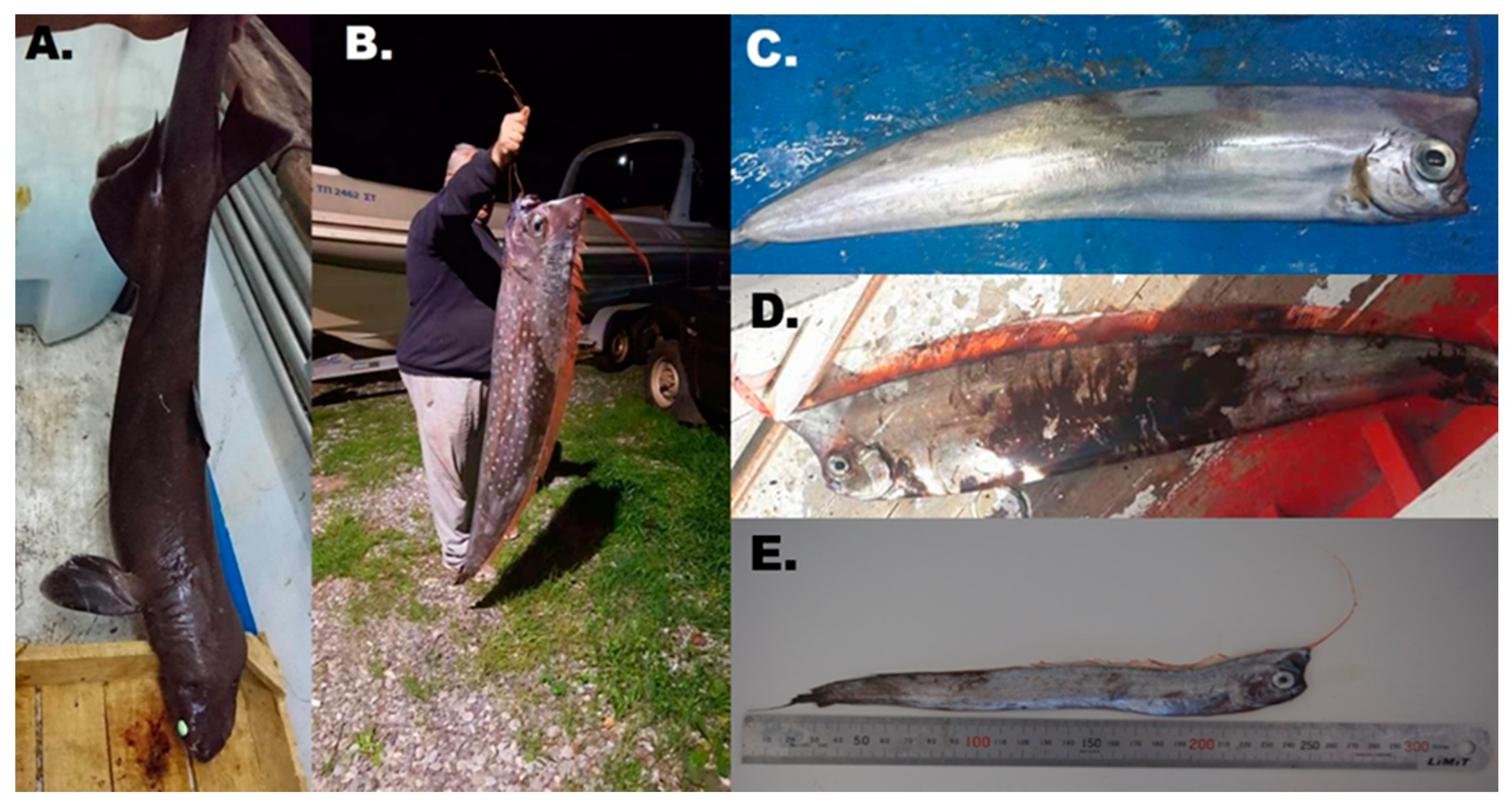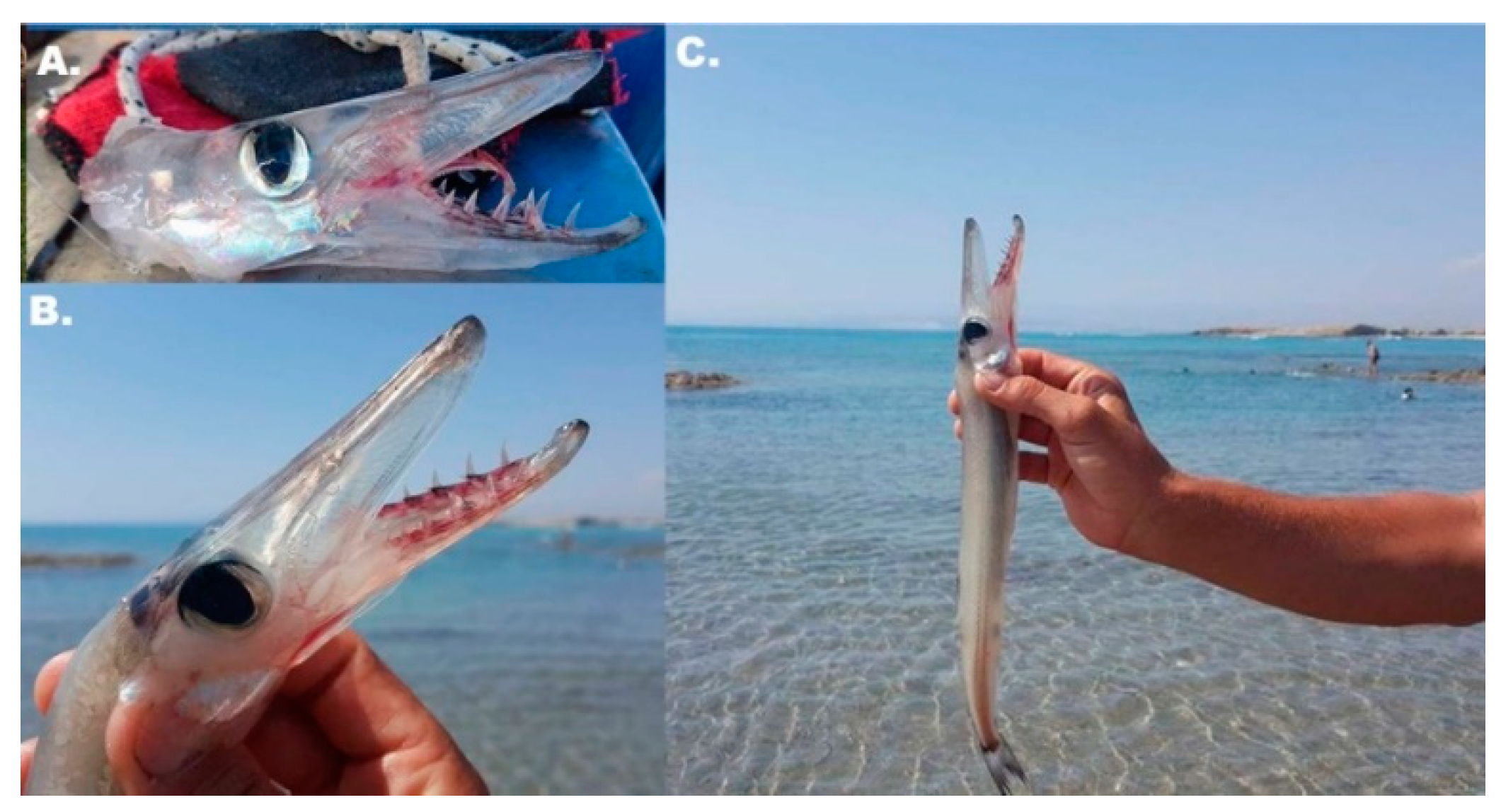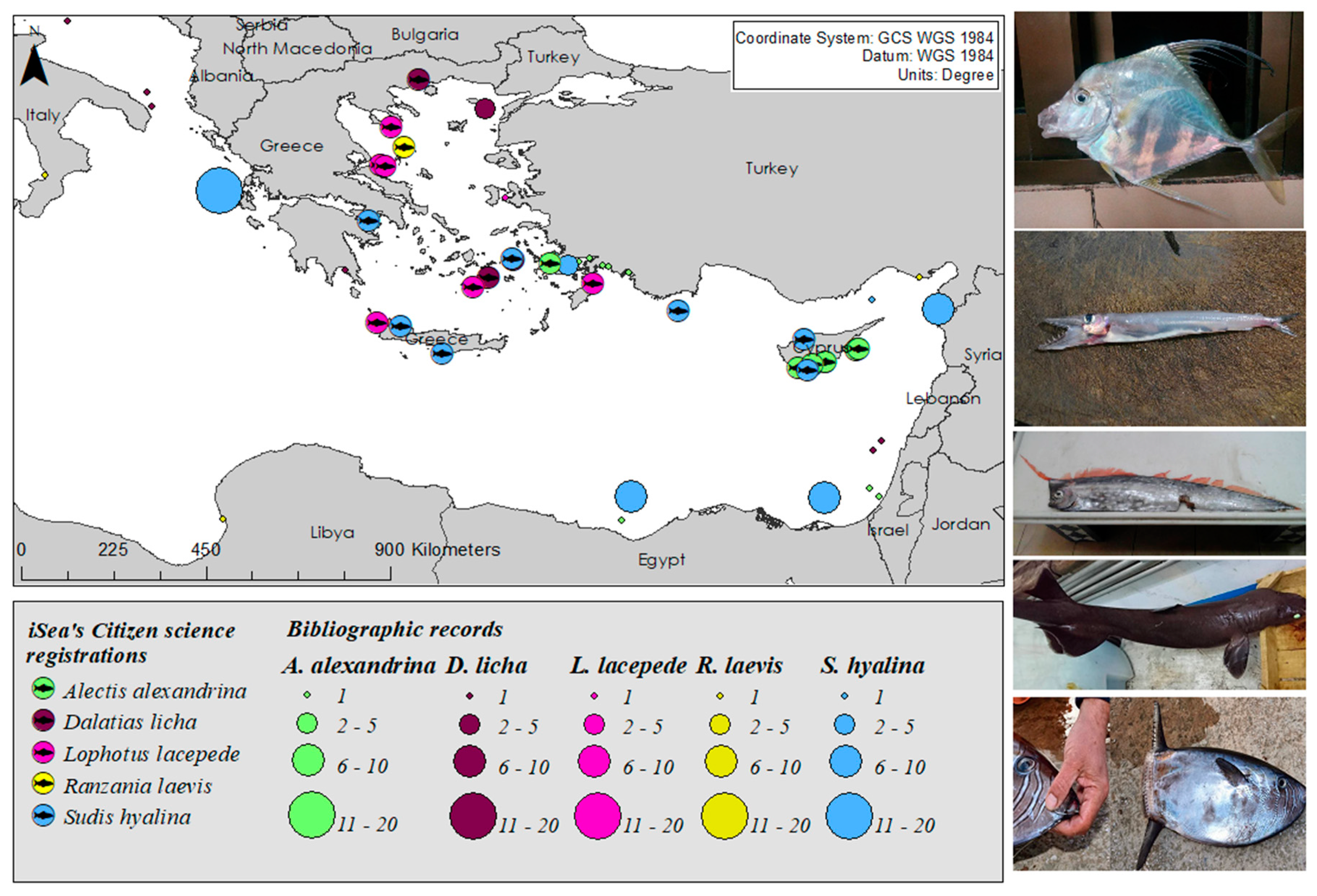Filling the Gap of Data-Limited Fish Species in the Eastern Mediterranean Sea: A Contribution by Citizen Science
Abstract
1. Introduction
2. Materials and Methods
3. Results
3.1. Alectis Alexandrina
3.2. Ranzania Laevis
3.3. Dalatias Licha
3.4. Lophotus Lacepede
3.5. Sudis Hyalina
4. Discussion
5. Conclusions
Supplementary Materials
Author Contributions
Funding
Acknowledgments
Conflicts of Interest
References
- Fortibuoni, T.; ldighieri, F.; Giovanardi, O.; Pranovi, F.; Zucchetta, M. Climate impact on Italian fisheries (Mediterranean Sea). Reg. Environ. Chang. 2015, 15, 931–937. [Google Scholar] [CrossRef]
- Macías, D.; Castilla-Espino, D.; García-del-Hoyo, J.J.; Navarro, G.; Catalán, I.A.; Renault, L.; Ruiz, J. Consequences of a future climatic scenario for the anchovy fishery in the Alboran Sea (SW Mediterranean): A modeling study. J. Mar. Syst. 2014, 135, 150–159. [Google Scholar] [CrossRef]
- Occhipinti-Ambrogi, A. Global change and marine communities: Alien species and climate change. Mar. Pollut. Bull. 2007, 55, 342–352. [Google Scholar] [CrossRef] [PubMed]
- Lejeusne, C.; Chevaldonné, P.; Pergent-Martini, C.; Boudouresque, C.F.; Perez, T. Climate change effects on a miniature ocean: The highly diverse, highly impacted Mediterranean Sea. Trends Ecol. Evol. 2010, 25, 250–260. [Google Scholar] [CrossRef] [PubMed]
- Lasram, B.R.F.; Guilhaumon, F.; Albouy, C.; Somot, S.; Thuiller, W.; Mouillot, D. The Mediterranean Sea as a ‘cul-de-sac’ for endemic fishes facing climate change. Glob. Chang. Biol. 2010, 16, 3233–3245. [Google Scholar] [CrossRef]
- Danovaro, R.; Company, J.B.; Corinaldesi, C.; D’Onghia, G.; Galil, B.; Gambi, C.; Gooday, A.J.; Lampadariou, N.; Luna, G.M.; Morigi, C.; et al. Deep-sea biodiversity in the Mediterranean Sea: The known, the unknown, and the unknowable. PLoS ONE 2010, 5, e11832. [Google Scholar] [CrossRef]
- Thorson, J.T.; Kell, L.T.; De Oliveira, J.A.A.; Sampson, D.B.; Punt, A.E. Development, testing, and evaluation of data-poor assessment and fisheries management methods. Fish. Res. 2015, 171, 1–200. [Google Scholar] [CrossRef]
- Ford, R.B.; Galland, A.; Clark, M.R.; Crozier, P.; Duffy, C.A.J.; Dunn, M.R.; Francis, M.P.; Wells, R. Qualitative (Level 1) Risk Assessment of the Impact of Commercial Fishing on New Zealand Chondrichthyans; New Zealand Aquatic Environment and Biodiversity Report; Ministry for Primary Industries: Wellington, New Zealand, 2015; Volume 157, 111p.
- Hobday, A.J.; Smith, A.D.M.; Stobutzki, I.C.; Bulman, C.; Daley, R.; Dambacher, J.M.; Deng, R.A.; Dowdneya, J.; Fullera, M.; Furlania, D.; et al. Ecological risk assessment for the effects of fishing. Fish. Res. 2011, 108, 372–384. [Google Scholar] [CrossRef]
- Berkson, J.; Barbieri, L.; Cadrin, S.; Cass-Calay, S.; Crone, P.; Dorn, P.; Friess, C.; Kobayashi, D.; Miller, T.J.; Patrick, W.S.; et al. Calculating Acceptable Biological Catch for Stocks That Have Reliable Catch Data Only (Only Reliable Catch Stocks—ORCS); NMFS-SEFSC-616; NOAA Technical Memorandum: Miami, FL, USA, 2011; 56p. [Google Scholar]
- Zhou, S.; Punt, A.E.; Ye, Y.; Ellis, N.; Dichmont, C.M.; Haddon, M.; Smith, D.C.; Smith, A.D.M. Estimating stock depletion level from patterns of catch history. Fish Fish. 2017, 18, 742–751. [Google Scholar] [CrossRef]
- Dick, E.J.; MacCall, A.D. Depletion-based stock reduction analysis: A catch-based method for determining sustainable yields for data-poor fish stocks. Fish. Res. 2011, 110, 331–341. [Google Scholar] [CrossRef]
- Hordyk, A.; Ono, K.; Sainsbury, K.; Loneragan, N.; Prince, J. Some explorations of the life history ratios to describe length composition, spawning-per-recruit, and the spawning potential ratio. ICES J. Mar. Sci. 2015, 72, 204–216. [Google Scholar] [CrossRef]
- Tulone, A.; Crescimanno, M.; Vrontis, D.; Galati, A. Are coastal communities able to pay for the protection of fish resources impacted by climate change? Fish. Res. 2020, 221, 105374. [Google Scholar] [CrossRef]
- Thiel, M.; Penna-Díaz, M.A.; Luna-Jorquera, G.; Salas, S.; Sellanes, J.; Stotz, W. Citizen scientists and marine research: Volunteer participants, their contributions, and projection for the future. Oceanogr. Mar. Biol. Annu. Rev. 2014, 52, 257–314. [Google Scholar] [CrossRef]
- Theobald, E.J.; Ettinger, A.K.; Burgess, H.K.; DeBey, L.B.; Schmidt, N.R.; Froehlich, H.E.; Parrish, J.K. Global change and local solutions: Tapping the unrealized potential of citizen science for biodiversity research. Biol. Conserv. 2015, 181, 236–244. [Google Scholar] [CrossRef]
- Cousins, J.A.; Huxham, M.; Winton, D. Using citizen science to address conservation issues related to climate change and coastal systems. In Science for Coastal and Marine Conservation; Cigliano, J.A., Ballard, J.A., Eds.; Routledge: London, UK, 2017; p. 20. [Google Scholar]
- Gerovasileiou, V.; Dailianis, T.; Panteri, E.; Michalakis, N.; Gatti, G.; Sini, M.; Dimitriadis, C.; Issaris, Y.; Salomidi, M.; Filiopoulou, I.; et al. CIGESMED for divers: Establishing a citizen science initiative for the mapping and monitoring of coralligenous assemblages in the Mediterranean Sea. Biodiver. Data J. 2016, 4, e8692. [Google Scholar] [CrossRef]
- Barash, A.; Salingre, S.; Grosmark, Y.; Rothman, S.; Stoilas, V.S.; Maximiadi, M.; Tuncer, S.; Lapinski, M.; Nuez, I.; Bakiu, R.; et al. The MECO project (Mediterranean Elasmobranch Citizen Observations): Creating a large-scale database of elasmobranchs observations using social media. In Proceedings of the 22nd Annual European Elasmobranch Association Meeting, Peniche, Portugal, 12–14 October 2018. [Google Scholar]
- Giovos, I.; Kleitou, P.; Poursanidis, D.; Batjakas, I.; Bernardi, G.; Crocetta, F.; Doumpas, N.; Kalogirou, S.; Kampouris, T.E.; Keramidas, I.; et al. Citizen-science for monitoring marine invasions and stimulating public engagement: A case project from the eastern Mediterranean. Biol. Invasions 2019, 21, 3707–3721. [Google Scholar] [CrossRef]
- Marshall, A.D.; Pierce, S.J. The use and abuse of photographic identification in sharks and rays. J. Fish. Biol. 2012, 80, 1361–1379. [Google Scholar] [CrossRef]
- Katsanevakis, S.; Moustakas, A. Uncertainty in Marine Invasion Science. Front. Mar. Sci. 2018, 5, 38. [Google Scholar] [CrossRef]
- Dulčić, J.; Beg Paklar, G.; Grbec, B.; Morović, M.; Matić, E.; Lipej, L. On the occurrence of the ocean sunfish Mola mola and slender sunfish Ranzania laevis in the Adriatic Sea. J. Mar. Biol. Assoc. UK 2007, 87, 789–796. [Google Scholar] [CrossRef]
- Caballero-Alfonso, A.; Ganzedo-López, U.; Díez-Díez, G.; Castro, J. New record of Ocythoe tuberculata (Cephalopoda: Ocythoidae) in the north-east Atlantic related to sea warming. Mar. Biodivers. Rec. 2009, 2, e79. [Google Scholar] [CrossRef]
- Andaloro, F.; Castriota, L.; Falautano, M.; Azzurro, E.; Deidun, A.; Fenech-Farrugia, A. Public feedback on early warning initiatives undertaken for hazardous non-indigenous species: The case of Lagocephalus sceleratus from Italian and Maltese waters. Manag. Biol. Invasion 2016, 7, 313–319. [Google Scholar] [CrossRef][Green Version]
- Kletou, D.; Hall-Spencer, J.M.; Kleitou, P. A lionfish (Pterois miles) invasion has begun in the Mediterranean Sea. Mar. Biodivers. Rec. 2016, 9, e46. [Google Scholar] [CrossRef]
- Bariche, M.; Azzurro, E. Enhancing Early Detection through Social Networks: A Facebook Experiment; Rapports et Proces-Verbaux Reunions Commission International Mer Mediterranee; Reunions Commission International: Monaco, 2016; Volume 41, p. 413. [Google Scholar]
- Langeneck, J.; Marcelli, M.; Bariche, M.; Azzurro, E. Social networks allow early detection of non indigenous species: First record of the red drum Sciaenops ocellatus (Actinopterygii: Perciformes: Sciaenidae) in Italian waters. Acta Adriat. 2017, 58, 365–370. [Google Scholar] [CrossRef]
- Papaconstantinou, C. Fauna Graeciae. An Updated Checklist of the Fishes in the Hellenic Seas; Monographs on Marine Sciences, 7; HCMR: Athens, Greece, 2014; p. 340. [Google Scholar]
- Tortonese, E. Molidae . In Fishes of the North-Eastern Atlantic and the Mediterranean; Whitehead, P.J.P., Bauchot, M.-L., Hureau, J.-C., Nielsen, J., Tortonese, E., Eds.; UNESCO: Paris, France, 1986; pp. 1348–1350. [Google Scholar]
- Bilecenoglu, M.; Taskavak, E.; Mater, S.; Kaya, M. Checklist of the marine fishes of Turkey. Zootaxa 2002, 113, 1–194. [Google Scholar] [CrossRef]
- Elbaraasi, H.; Elsalini, O. Occurrence of slender sunfish Ranzania laevis Pennant, 1776, (Molidae) in the eastern part of the Libyan coast (southern Mediterranean). Turk J. Fish Aquat. Sci. 2010, 10, 549–550. [Google Scholar] [CrossRef]
- Goren, M.; Galil, B.S. A checklist of the deep sea fishes of the Levant Sea, Mediterranean Sea. Zootaxa 2015, 3994, 507–530. [Google Scholar] [CrossRef]
- Farrag, M.M.S. Deep-sea ichthyofauna from Eastern Mediterranean Sea, Egypt: Update and new records. Egypt. J. Aquat. Res. 2016, 42, 479–489. [Google Scholar] [CrossRef]
- Ragonese, S.; Vitale, S.; Dimech, M.; Mazzola, S. Abundances of demersal sharks and chimaera from 1994-2009 scientific surveys in the central Mediterranean Sea. PLoS ONE 2013, 8. [Google Scholar] [CrossRef]
- Navarro, J.; López, L.; Coll, M.; Barría, C.; Saez-Liante, R. Short- and long-term importance of small sharks in the diet of the rare deep-sea shark Dalatias licha. Mar. Biol. 2014, 161, 1697–1707. [Google Scholar] [CrossRef]
- Corsini-Foka, M. Uncommon fished from Rhodes and nearby marine region (SE Aegean Sea, Greece). J. Biol. Res. Thessaloniki 2009, 12, 125–133. [Google Scholar]
- Ergüden, D.; Çekic, M.; Alagoz Ergüden, S.; Altun, A.; Uygur, N. Occurrence of adult female Kitefin shark Dalatias licha (Bonnaterre, 1788) in Iskenderun Bay (Eastern Mediterranean, Turkey). Commagene J. Biol. 2017, 1, 60–62. [Google Scholar] [CrossRef][Green Version]
- Walls, R.H.L.; Guallart, J. Dalatias licha; The IUCN Red List of Threatened Species 2016: E.T6229A16527825. IUCN, 2016. Available online: http://www.iucnredlist.org/details/6229/16527825 (accessed on 10 February 2020).
- Minos, G.; Karidas, T.; Economidis, P.S. Range extension for crested oarfish Lophotus lacepede Giorna, 1809 in the waters of the northern Aegean Sea, Greece. Acta Adriat. 2015, 56, 283–290. [Google Scholar]
- Türker, D.; Kara, A.; Bal, H.; Tünay, Ö.K. Occurrence of rare deep-water fish Sudis hyalina Rafinesque, 1810 (Paralepididae) in Gökova Bay, Aegean Sea of Turkey. J. Appl. Ichthyol. 2017, 33, 535–538. [Google Scholar] [CrossRef]
- Ceyhan, T.; Akyol, O. Additional record of Alectis alexandrina (Carangidae) from the north-western Levantine Sea (Fethiye, Turkey). Ann. Ser. Hist. Nat. 2016, 26, 221–223. [Google Scholar] [CrossRef]
- Goren, M.; Galil, B.S.; Diamant, A.; Stern, N.; Levitt-Barmats, Y. Invading up the food web? Invasive fish in the southeastern Mediterranean Sea. Mar. Biol. 2016, 163, 180. [Google Scholar] [CrossRef]
- Chatzispyrou, A.; Aroni, M.; Lefkaditou, E.; Kapiris, K.; Giovos, I.; Anastasopoulou, A. Some Biological Information on a Female Kitefin Shark, Dalatias licha (Bonnaterre, 1788) Stranded in the Laconikos Gulf of Greece (SE Ionian Sea). Turk. J. Fish. Aquat. Sci. 2019, 19, 1069–1072. [Google Scholar] [CrossRef]
- Yapici, S. New and additional records of rare fish species from the Anatolian coasts of Turkey. Mugla J. Sci. Technol. 2019, 5, 13–15. [Google Scholar] [CrossRef][Green Version]
- Ergüden, D.; Gürlek, M.; Ergüden, S.A.; Ayas, D.; Altun, A. Presence of Ranzania laevis (Pennant, 1776) in Iskenderun Bay, Turkey. Thalassas Int. J. Mar. Sci. 2019. [Google Scholar] [CrossRef]




| n | Species | N Individuals | Depth | TL | Area | Coordinates | Type of Observation |
|---|---|---|---|---|---|---|---|
| 1 | A. alexandrina | 2 | N/A | 10 | Protaras, Cyprus | 35°00′48.6″ N, 34°02′14.6″ E | UW |
| 2 | A. alexandrina | 1 | N/A | 45 | Zygi, Cyprus | 34°43′35.3″ N, 33°20′15.0″ E | SF |
| 3 | A. alexandrina | 1 | 5 | 45 | Old port of Limassol, Cyprus | 34°40′13.8″ N, 33°02′34.8″ E | SF |
| 4 | A. alexandrina | 1 | N/A | 50 | Port of Kos Island, Greece | 36°53′43.8″ N, 27°17′19.0″ E | SF |
| 5 | A. alexandrina | 1 | N/A | 22 | Zygi, Cyprus | 34°43′41.5″ N, 33°20′25.8″ E | S |
| 6 | A. alexandrina | 1 | 5 | 60 | Akrotiri Bay, Cyprus | 34°33′20.2″ N, 33°00′59.8″ E | SF |
| 7 | A. alexandrina | 1 | 4 | 15 | Ayia Napa, Cyprus | 34°58′53.0″ N, 34°00′17.9″ E | SF |
| 8 | A. alexandrina | 1 | N/A | 45 | Zygi, Cyprus | 34°40′15.7″ N, 33°02′39.4″ E | S |
| 9 | A. alexandrina | 1 | 3,5 | 6,5 | Protaras, Cyprus | 35°00′30.1″ N, 34°03′48.4″ E | UW |
| 10 | R. laevis | 1 | 200 | 53 | Psathoura island, Greece | 39°26′46.0″ N, 24°04’46.1"E | LL |
| 11 | D. licha | 1 | 612 | 150 | Levitha island, Greece | 36°58′23.2″ N, 26°29′11.4″ E | LL |
| 12 | D. licha | 1 | 580 | 150 | Amorgos island, Greece | 36°46′25.7″ N, 26°02′38.0″ E | LL |
| 13 | L. lacepede | 1 | 500 | 160 | Between Skopelos and Euboea island, Greece | 36°46′25.7″ N, 23°34′44.0″ E | LL |
| 14 | L. lacepede | 1 | 500 | 140 | Between Skopelos and Euboea island, Greece | 36°46′25.7″ N, 23°34′44.0″ E | LL |
| 15 | L. lacepede | 1 | 540 | 60 | Between Santorini and Anafi island, Greece | 36°22′39.4″ N, 25°35′44.5″ E | LL |
| 16 | L. lacepede | 1 | 300 | 100 | Chalkidiki Peninsula, Greece | 39°44′10.7″ N, 23°22′56.6″ E | LL |
| 17 | L. lacepede | 1 | 540 | 140 | Crete island, Greece | 35°34′58.0″ N, 23°29′29.1″ E | LL |
| 18 | L. lacepede | 1 | 40 | 25 | Rhodes island, Greece | 36°27′21.6″ N, 28°13′05.5″ E | BS |
| 19 | S. hyalina | 1 | 700 | N/A | Kastellorizo island, Greece | 35°51′41.4″ N, 30°06′32.0″ E | LL |
| 20 | S. hyalina | 1 | 200 | 30 | Akrotiri Bay, Cyprus | 34°32′46.0″ N, 32°56′56.4″ E | SF |
| 21 | S. hyalina | 1 | 100 | N/A | Crete island, Greece | 35°31′20.8″ N, 24°00′55.5″ E | BS |
| 22 | S. hyalina | 1 | 300 | 40 | Morfou Gulf, Cyprus | 35°13′43.4″ N, 32°52′01.1″ E | BS |
| 23 | S. hyalina | 1 | 400 | N/A | Crete island, Greece | 34°54′55.1″ N, 24°54′50.6″ E | BS |
| 24 | S. hyalina | 1 | 100 | N/A | Saronikos Gulf, Athens | 37°50′12.0″ N, 23°18′50.7″ E | BS |
| 25 | S. hyalina | 1 | 612 | 35 | Levitha island, Greece | 37°00′02.9″ N, 26°27′32.6″ E | LL |
© 2020 by the authors. Licensee MDPI, Basel, Switzerland. This article is an open access article distributed under the terms and conditions of the Creative Commons Attribution (CC BY) license (http://creativecommons.org/licenses/by/4.0/).
Share and Cite
Naasan Aga Spyridopoulou, R.; Langeneck, J.; Bouziotis, D.; Giovos, I.; Kleitou, P.; Kalogirou, S. Filling the Gap of Data-Limited Fish Species in the Eastern Mediterranean Sea: A Contribution by Citizen Science. J. Mar. Sci. Eng. 2020, 8, 107. https://doi.org/10.3390/jmse8020107
Naasan Aga Spyridopoulou R, Langeneck J, Bouziotis D, Giovos I, Kleitou P, Kalogirou S. Filling the Gap of Data-Limited Fish Species in the Eastern Mediterranean Sea: A Contribution by Citizen Science. Journal of Marine Science and Engineering. 2020; 8(2):107. https://doi.org/10.3390/jmse8020107
Chicago/Turabian StyleNaasan Aga Spyridopoulou, Roxani, Joachim Langeneck, Dimitris Bouziotis, Ioannis Giovos, Periklis Kleitou, and Stefanos Kalogirou. 2020. "Filling the Gap of Data-Limited Fish Species in the Eastern Mediterranean Sea: A Contribution by Citizen Science" Journal of Marine Science and Engineering 8, no. 2: 107. https://doi.org/10.3390/jmse8020107
APA StyleNaasan Aga Spyridopoulou, R., Langeneck, J., Bouziotis, D., Giovos, I., Kleitou, P., & Kalogirou, S. (2020). Filling the Gap of Data-Limited Fish Species in the Eastern Mediterranean Sea: A Contribution by Citizen Science. Journal of Marine Science and Engineering, 8(2), 107. https://doi.org/10.3390/jmse8020107








